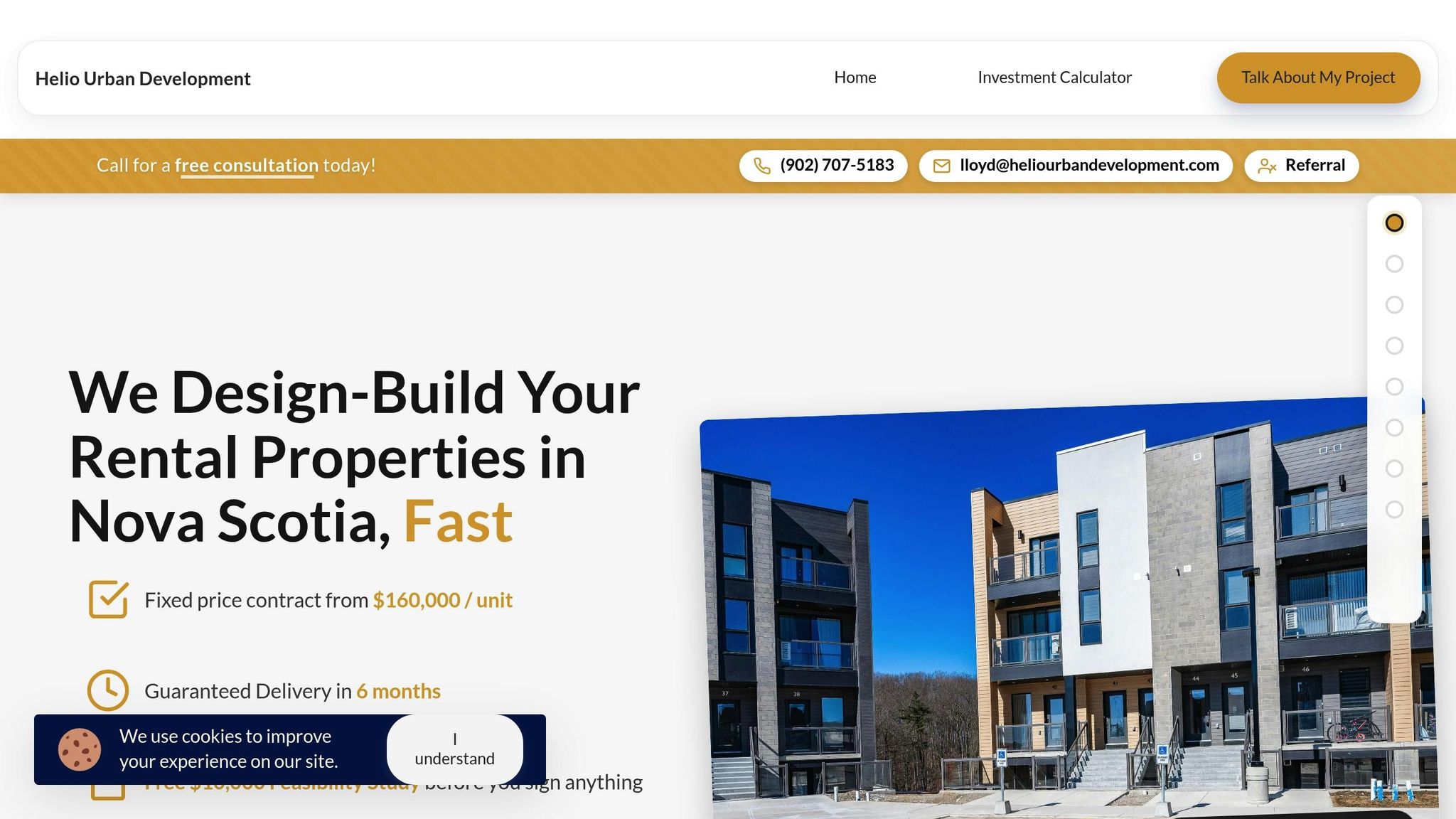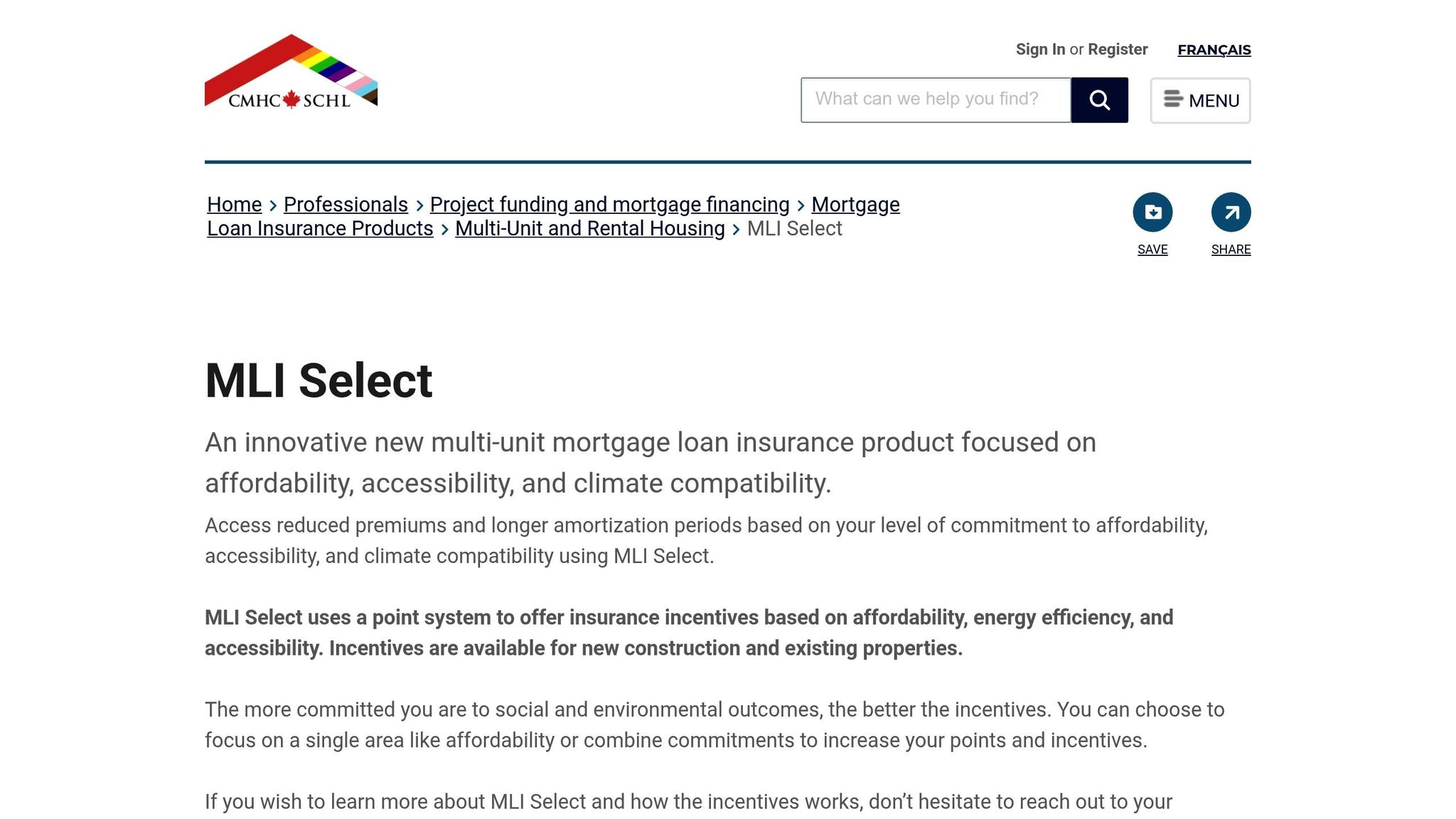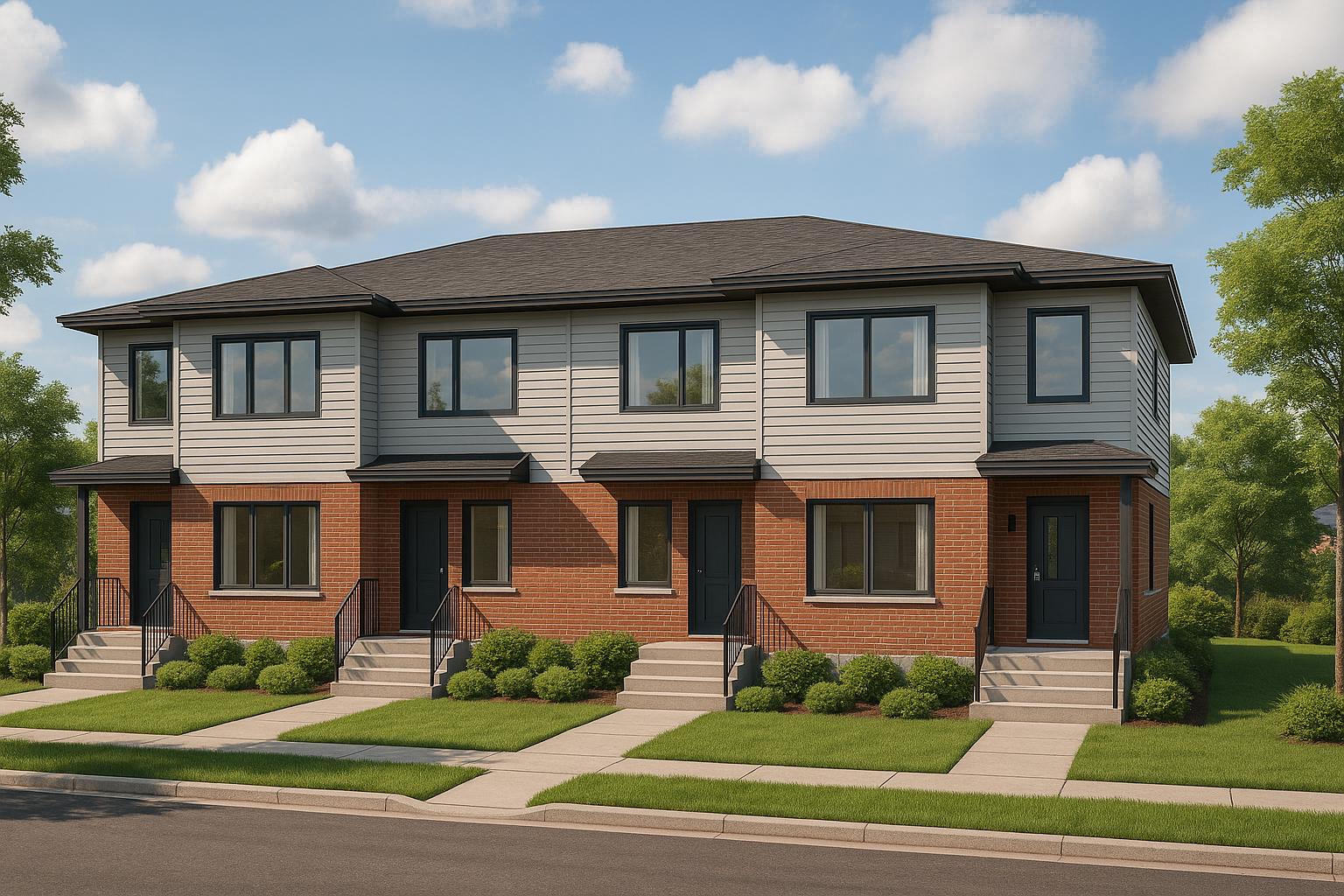Halifax’s ER-3 zoning offers property owners a profitable opportunity to develop student housing near universities. With high demand, predictable rental income aligned to academic calendars, and streamlined approval processes, ER-3 zones are ideal for multi-unit housing projects tailored to student needs.
Here’s what you need to know:
- ER-3 Zoning Basics: Allows for flexible housing types like townhomes, duplexes, and three-unit dwellings, with reduced permit requirements and strategic placement near transit routes and universities.
- Construction Costs: Expect $160,000–$200,000 per unit, with options for energy-efficient builds under CMHC MLI Select to unlock 95% financing and 50-year amortization.
- Rental Income: Units typically rent for $1,950–$2,100/month, generating $96,000–$100,800 annually for a fourplex.
- Streamlined Building: Integrated design-build models cut construction timelines to six months, ensuring projects are ready for September move-ins, while fixed-price contracts eliminate budget surprises.
To succeed, ensure your property meets ER-3 zoning rules, secure financing early, and work with experienced teams to avoid delays and maximize returns. Halifax’s strong rental market and zoning flexibility make ER-3 zones a smart choice for student housing.
ER-3 Zoning Rules in Halifax
ER-3 Zoning Basics
ER-3 zoning plays a key role in Halifax's "Missing Middle" housing strategy, bridging the gap between single-family homes and larger apartment complexes [1]. This zoning category offers more flexibility, allowing property owners to explore housing designs that aren't feasible in more restrictive zones.
With ER-3 zoning, property owners can construct a range of housing types, including single-family homes, duplexes, semi-detached houses, three-unit dwellings, townhomes, backyard suites, and secondary suites [2]. These options make it easier to create shared living spaces while also boosting rental income opportunities.
ER-3 zones are strategically placed along major transit routes [2], ensuring convenient access to universities and other important destinations. Most developments in these zones only require a permit, skipping the need for site plan approval [2]. This streamlined process helps reduce both administrative costs and project timelines.
ER-3 Development Requirements
Understanding ER-3 zoning regulations is crucial for property owners considering student housing projects. The specific requirements depend on the type of dwelling being planned.
| Development Requirement | Specification |
|---|---|
| Minimum Lot Area | 1-4 unit dwellings: 325 sq. m; Townhouse interior: 130 sq. m; Townhouse end unit: 245 sq. m [2] |
| Maximum Building Height | 8.0 to 11 metres, depending on dwelling type [2] |
| Maximum Lot Coverage | 40% (35%-50% in Special Areas) [2] |
| Minimum Side Setback | 1.25 metres [2] |
| Minimum Rear Setback | 6.0 metres [2] |
| Front Setback | 0.5 to 4.5 metres [2] |
Lot coverage limits ensure there’s enough space for outdoor areas, parking, and landscaping, all of which enhance a property's appeal to student tenants.
In addition to residential uses, ER-3 zoning allows for home-based businesses, daycares, and bed and breakfast establishments [2]. These added options provide property owners with opportunities to diversify their income streams while complementing student housing operations. The regulations are designed to balance density with functionality, making them ideal for student-focused developments.
Why ER-3 Works for Student Housing
ER-3 zoning meets the unique demands of student housing by accommodating multi-unit dwellings like three-unit homes and townhouses, which are popular for shared living arrangements [2]. Compared to ER-1 and ER-2 zones, ER-3 offers higher density, enabling property owners to house more students on a single lot and maximize rental income.
The strategic placement of ER-3 zones along major transit corridors ensures students have easy access to campuses, downtown jobs, and recreational areas. This reduces the need for extensive parking, freeing up more land for residential use.
The zoning's flexibility also caters to a variety of student preferences. For example, undergraduates might prefer living with roommates in townhouses, while graduate or international students may opt for smaller, private units like secondary suites. This adaptability makes ER-3 zoning a practical choice for student housing developments.
Many university students can't find housing even after semester starts
How to Build Student Housing in ER-3 Zones
Developing student housing in ER-3 zones calls for thoughtful planning and a step-by-step approach to avoid unnecessary setbacks and delays.
Check Your Property and Project Feasibility
First, ensure your property aligns with ER-3 zoning rules and local municipal requirements. Properties near universities like Dalhousie, Saint Mary’s, or NSCAD are often more lucrative, offering higher rental income and lower vacancy rates.
Take a close look at any existing structures on the property. If the building is older and has major issues - like foundation problems or outdated electrical systems - demolition might be a better option. Also, evaluate the site conditions, including soil quality, drainage, and utility access, to get a clear picture of potential construction costs.
When calculating project feasibility, consider potential rental income. For instance, two-bedroom units near Halifax universities typically rent for $1,950–$2,100 per month. Combine this with construction costs, financing expenses, and ongoing maintenance to determine if the project makes financial sense. Once you confirm the numbers work, move forward by securing the necessary permits.
Get Permits and Municipal Approvals
In ER-3 zones, the approval process is often more straightforward, with many projects requiring only a permit instead of a full site plan review. However, be prepared for potential pushback from the community, especially in well-established neighbourhoods near universities.
For example, in October 2024, Halifax's South End saw a heated debate over an ER-3 rezoning decision that allowed multi-unit developments. Some residents argued that the area’s infrastructure couldn’t handle the additional housing, while others worried about the impact on property values. The opposition even included prominent figures, such as a CEO from a major Canadian REIT and members of a well-known Halifax developer family [1].
To avoid delays, engage with local councillors early in the process and submit complete applications that include detailed plans, engineering reports, and surveys. Once your permits are approved, focus on assembling a skilled team to bring the project to life.
Hire the Right Professionals
Managing multiple contractors for a project can lead to coordination problems, budget overruns, and timeline delays. Often, it’s hard to pinpoint accountability when various teams are involved.
Instead, consider hiring professionals with specific expertise in multi-unit residential and student housing projects. An integrated design-build approach can simplify the process by bringing all necessary experts under one roof. This approach typically offers fixed-price construction, guaranteed timelines, and reduced uncertainty.
Make sure your team understands financing requirements, especially if you’re planning to use programs like the CMHC MLI Select program. While construction costs for such projects often hover around $200,000 per unit, these standards may unlock better financing options, such as 95% coverage and 50-year amortization, which can greatly improve cash flow.
Before making your final decision, review the team’s past student housing projects and ask for references. Look for feedback on their ability to stick to timelines, manage budgets, and provide support after construction. A strong, integrated team can make all the difference in keeping your project on track and within budget.
Increase ROI Through Integrated Construction
Fragmented construction processes in Halifax's ER-3 zones often lead to delays in student housing projects. These delays result in lost rental income and increased costs, making a more streamlined approach essential.
Benefits of Integrated Design-Build
The integrated design-build model brings planners, architects, engineers, and construction teams together under one roof. By eliminating the need for multiple contractors, this approach avoids the common coordination issues that arise in traditional construction methods. Here’s how it compares:
| Traditional Construction | Integrated Design-Build |
|---|---|
| Multiple contracts to manage | Single contract with full accountability |
| Cost-plus pricing with frequent overruns | Fixed-price construction |
| 12–18 month construction timeline | 6-month guaranteed delivery |
| Blame-shifting between contractors | One team responsible for all aspects |
| Budget overruns of 30–60% | Pricing locked into contracts |
| Unpredictable outcomes | Systematic delivery with penalties for delays |
This model directly improves ROI by cutting delays and protecting income streams. For instance, integrated teams can save around $47,000 per project by reducing coordination waste. By preventing miscommunications and rework - common in traditional methods - costs are kept under control.
Fixed-price contracts also eliminate surprise expenses, making it easier to secure financing. Plus, the six-month timeline ensures student housing is ready for September move-ins, maximizing rental income during peak periods.
How Helio Urban Development Helps Property Owners

Helio Urban Development leverages the integrated design-build model to address the unique challenges of rental property construction in Nova Scotia. As the province’s only design-build company specializing in 4+ unit rental properties, Helio offers a comprehensive solution to avoid coordination chaos, budget overruns, and timeline delays.
Founded by Lloyd Liu, a Yale MBA and former Merrill Lynch investment banker, and Yuan He, a University of Pennsylvania-trained data scientist, Helio combines financial expertise with advanced scheduling systems. Their approach delivers fixed-price construction at $160,000–$200,000 per unit and guarantees six-month project completion. To safeguard property owners, the company enforces a $1,000-per-day penalty for delays. For a fourplex generating roughly $8,000 per month in rental income, this certainty can mean substantial savings.
Helio’s scheduling systems, developed by Yuan He, cut project timelines from 12–18 months to just six months. Property owners can stay informed through real-time project updates, including daily photos via a dedicated portal.
To ensure quality, Helio employs a triple-verification process, including inspections at five critical stages by a Professional Engineer. The property owner also has the final say in selecting the inspector. Currently, Helio is managing 31 units under construction and has plans for 131 more units across Nova Scotia, serving municipalities within a 90-minute radius of Halifax.
This integrated approach not only streamlines construction but also aligns with student rental rates of $1,950–$2,100 per month, helping property owners maximize their returns.
sbb-itb-16b8a48
Construction Costs and Money Matters
Navigating the financial side of building student housing in Halifax's ER-3 zones is key for property owners aiming to make smart investment decisions. With rental prices climbing over 11% in the past year and vacancy rates sitting stubbornly around 1.0%, the demand for rental properties remains high [3]. These market conditions underline the importance of balancing costs and efficiency during construction.
Construction Costs Per Unit
A basic build in Halifax’s ER-3 zones costs approximately $160,000 per unit. This includes quality features like triple-pane windows, ductless heat pumps, quartz countertops, and engineered hardwood flooring. These figures assume a minimum project size of four units.
For those seeking financing, the CMHC MLI Select construction option is available at $200,000 per unit. These units are designed to exceed energy efficiency standards by 40% and qualify for special financing. Although the upfront cost is $40,000 higher per unit, the financing benefits can help offset this difference over time.
Additionally, property owners can opt for the Premium Rental Ready Package at an additional $15,000 per unit. This package includes Energy Star appliances, smart home technology, window blinds, and essential bathroom accessories. It offers a savings of about $3,000 per unit compared to purchasing these items separately and ensures quicker rental readiness.
Rental Income and ROI Numbers
Student housing units in Halifax’s ER-3 zones typically generate monthly rental incomes of $1,950 to $2,100 per unit. For a standard fourplex, this translates to around $8,000 to $8,400 per month, or approximately $96,000 to $100,800 annually in gross rental income. Many property owners see annual returns on investment (ROI) ranging from 12% to 20%, though actual returns depend on variables like land costs, financing terms, and local rental rates.
Halifax’s population growth - ranging between 2% and 4.5% annually - is another important factor. With more than 20,000 new residents added last year and a housing shortage of roughly 20,000 units, demand for student housing is expected to remain strong [3].
Financing Options and CMHC MLI Select Program

Traditional construction financing generally requires property owners to contribute 20% to 25% of the total project cost upfront. For a fourplex costing $640,000, this would mean a down payment of about $128,000 to $160,000.
However, the CMHC MLI Select program offers a more accessible alternative. By constructing energy-efficient units that meet the program's criteria, property owners can secure up to 95% financing, reducing the required down payment to just 5%. For example, an $800,000 CMHC-compliant fourplex would require only a $40,000 down payment.
The program also extends the amortization period to 50 years, compared to the typical 25-year term. This longer timeline lowers monthly mortgage payments, often allowing property owners to achieve positive cash flow from the outset. It’s important to confirm financing details early to ensure smooth project execution.
Compliance Tips and Best Practices
Navigating Halifax's evolving planning framework is essential for those looking to build student housing in ER-3 zones. As the Halifax Regional Municipality updates its Regional Municipal Planning Strategy to align with new provincial requirements, property owners must stay informed to adapt their projects accordingly. These changes can have a direct impact on development strategies, making it crucial to keep up with the latest regulations.
Stay Updated on Zoning Changes
On June 19, 2025, the Halifax Regional Council approved a motion to adopt the proposed 2025 Regional Municipal Planning Strategy. This plan is now under review and awaiting a "Notice of Approval" from the Provincial Planning Director [4]. The updates are expected to influence several key development factors, such as unit mix, parking standards, building height measurements, and the use of ground-floor spaces for commercial purposes.
To ensure your project aligns with the latest requirements, consider the following:
- Monitor official updates: Regularly check the municipality’s website for announcements, including the "Notice of Approval" for the new planning strategy.
- Review official documents: Look at staff reports, council meeting agendas (like the June 19, 2025 Special Regional Council agenda), and planning summaries to understand the specifics of the new regulations.
- Confirm applicable by-laws: Use the Community Plan Areas page on the municipal website to verify which land use by-laws apply to your property.
- Reach out to planning staff: For detailed questions about the new Regional Municipal Planning Strategy or amendment packages, contact the Regional Planning Team at regionalplan@halifax.ca.
Conclusion: Making ER-3 Student Housing Work
Developing student housing in Halifax's ER-3 zones presents a promising opportunity for property owners who come prepared. With high rental demand near universities, zoning regulations that support such projects, and reliable construction techniques available, the path forward becomes much clearer when approached with a solid plan.
While strong rental demand and appealing returns make these projects enticing, success isn’t just about having the right location. It hinges on thoughtful planning, compliance with regulations, and effective construction management that stays within budget and on schedule.
The financial benefits highlight the importance of dependable construction practices. Disjointed approaches often lead to delays and increased costs, putting both timelines and returns at risk. Opting for an integrated design-build model helps lock in costs and schedules, minimizing potential setbacks.
To move forward, start by verifying if your property qualifies under ER-3 zoning. Familiarize yourself with current regulations, secure financing through options like CMHC MLI Select, and collaborate with experienced construction professionals who deliver on their promises. Halifax’s student housing market remains strong, and ER-3 zoning provides a solid foundation to meet this demand profitably.
Ultimately, success in student housing development boils down to careful planning and execution. Property owners who prioritize systematic strategies, regulatory requirements, and proven construction methods will find ER-3 zones to be a reliable avenue for generating steady rental income in Halifax’s competitive market. By following this integrated approach, you can confidently navigate the opportunities in Halifax’s student housing sector.
FAQs
What are the advantages of using the design-build approach for student housing projects in Halifax's ER-3 zones?
The design-build method streamlines the construction of student housing in Halifax's ER-3 zones by merging the design and construction phases into one cohesive process. This integrated workflow promotes clear communication and teamwork, helping to minimise errors and ensuring projects run more smoothly.
By tackling potential risks early on, this approach helps prevent delays, keeps costs steady, and delivers top-notch results. For property owners, it means quicker project completion, fewer complications, and a more straightforward experience - an excellent fit for multi-unit housing developments close to universities.
How can the CMHC MLI Select program help finance student housing projects in Halifax's ER-3 zoning areas?
The CMHC MLI Select program is a game-changer for property owners in Halifax's ER-3 zones who are planning student housing projects. It offers perks like higher loan-to-value ratios, longer amortization periods, and reduced insurance premiums. This makes it much easier to secure affordable financing for constructing or upgrading multi-unit rental properties.
These financing options are tailored to encourage the creation of affordable, energy-efficient rental housing, including spaces for students. This not only helps meet the growing local demand but also allows property owners to enhance their investment potential.
What should property owners know about building student housing near universities in Halifax?
When developing student housing near universities in Halifax, it's crucial for property owners to familiarize themselves with ER-3 zoning regulations. These regulations permit multi-unit buildings ranging from 8 to 12 metres in height, typically accommodating 4 to 8 units. Before moving forward, confirm whether your project requires permits for new builds or conversions, as well as Site Plan Approval.
Being close to campuses is essential for attracting tenants and maintaining strong demand. However, owners should also account for potential infrastructure upgrades and ensure all zoning requirements are met. Proper planning in these areas can help keep costs under control, stay on schedule, and achieve a better return on investment.



